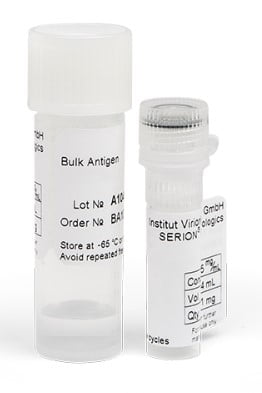| Weight | 1 lbs |
|---|---|
| Dimensions | 9 × 5 × 2 in |
| host | rabbit |
| isotype | IgG |
| clonality | polyclonal |
| concentration | 1 mg/mL |
| applications | ICC/IF, WB |
| reactivity | HNF4α (phospho-Ser304) |
| available sizes | 100 µL |
rabbit anti-HNF4 α (phospho-Ser304) polyclonal antibody 8472
$366.00
Antibody summary
- Rabbit polyclonal to HNF4 α (phospho-Ser304)
- Suitable for: WB
- Isotype: Whole IgG
- 100 µl
rabbit anti-HNF4 α (phospho-Ser304) polyclonal antibody 8472
| antibody |
|---|
| Tested applications WB |
| Recommended dilutions Immunoblotting: use at dilution of 1:1,000. A band of ~52kDa is detected. These are recommended working dilutions. End user should determine optimal dilutions for their applications |
| Immunogen Peptide sequence that includes phosphorylation site of Serine 304 (L-R-S(p)-Q-V) derived from human HNF4a and conjugated to KLH. |
| Size and concentration 100µL and 1 mg/mL |
| Form liquid |
| Storage Instructions This antibody is stable for at least one (1) year at -20°C. |
| Storage buffer PBS (without Mg2 and Ca2 ), pH 7.4, 150mM NaCl, |
| Purity affinity purified |
| Clonality polyclonal |
| Isotype IgG |
| Compatible secondaries goat anti-rabbit IgG, H&L chain specific, peroxidase conjugated, conjugated polyclonal antibody 9512 goat anti-rabbit IgG, H&L chain specific, biotin conjugated polyclonal antibody 2079 goat anti-rabbit IgG, H&L chain specific, FITC conjugated polyclonal antibody 7863 goat anti-rabbit IgG, H&L chain specific, Cross Absorbed polyclonal antibody 2371 goat anti-rabbit IgG, H&L chain specific, biotin conjugated polyclonal antibody, crossabsorbed 1715 goat anti-rabbit IgG, H&L chain specific, FITC conjugated polyclonal antibody, crossabsorbed 1720 |
| Isotype control Rabbit polyclonal - Isotype Control |
| target relevance |
|---|
| Protein names Hepatocyte nuclear factor 4-alpha (HNF-4-alpha) (Nuclear receptor subfamily 2 group A member 1) (Transcription factor 14) (TCF-14) (Transcription factor HNF-4) |
| Gene names HNF4A,HNF4A HNF4 NR2A1 TCF14 |
| Protein family Nuclear hormone receptor family, NR2 subfamily |
| Mass 52785Da |
| Function FUNCTION: Transcriptional regulator which controls the expression of hepatic genes during the transition of endodermal cells to hepatic progenitor cells, facilitating the recruitment of RNA pol II to the promoters of target genes (PubMed:30597922). Activates the transcription of CYP2C38 (By similarity). Represses the CLOCK-BMAL1 transcriptional activity and is essential for circadian rhythm maintenance and period regulation in the liver and colon cells (PubMed:30530698). {ECO:0000250|UniProtKB:P49698, ECO:0000269|PubMed:30530698, ECO:0000269|PubMed:30597922}. |
| Subellular location SUBCELLULAR LOCATION: Nucleus. |
| Structure SUBUNIT: Homodimerization is required for HNF4-alpha to bind to its recognition site (PubMed:14982928). Interacts with CLOCK, BMAL1, CRY1, CRY2, PER1 and PER2 (PubMed:30530698). Interacts with NR0B2/SHP; the resulting heterodimer is transcriptionally inactive (PubMed:28128295). Interacts with DDX3X; this interaction disrupts the interaction between HNF4 and NR0B2 that forms inactive heterodimers and enhances the formation of active HNF4 homodimers (PubMed:28128295). {ECO:0000269|PubMed:14982928, ECO:0000269|PubMed:28128295, ECO:0000269|PubMed:30530698}. |
| Post-translational modification PTM: Phosphorylated on tyrosine residue(s); phosphorylation is important for its DNA-binding activity. Phosphorylation may directly or indirectly play a regulatory role in the subnuclear distribution. Phosphorylation at Ser-313 by AMPK reduces the ability to form homodimers and bind DNA. {ECO:0000269|PubMed:12740371, ECO:0000269|PubMed:21708125, ECO:0000269|PubMed:7568236}.; PTM: Acetylation at Lys-458 lowers transcriptional activation by about two-fold. {ECO:0000269|PubMed:21708125}. |
| Domain DOMAIN: The 9aaTAD motif is a transactivation domain present in a large number of yeast and animal transcription factors. {ECO:0000305|PubMed:30468856}. |
| Involvement in disease DISEASE: Maturity-onset diabetes of the young 1 (MODY1) [MIM:125850]: A form of diabetes that is characterized by an autosomal dominant mode of inheritance, onset in childhood or early adulthood (usually before 25 years of age), a primary defect in insulin secretion and frequent insulin-independence at the beginning of the disease. {ECO:0000269|PubMed:10389854, ECO:0000269|PubMed:17407387, ECO:0000269|PubMed:9243109, ECO:0000269|PubMed:9313765}. Note=The disease is caused by variants affecting the gene represented in this entry.; DISEASE: Type 2 diabetes mellitus (T2D) [MIM:125853]: A multifactorial disorder of glucose homeostasis caused by a lack of sensitivity to insulin. Affected individuals usually have an obese body habitus and manifestations of a metabolic syndrome characterized by diabetes, insulin resistance, hypertension and hypertriglyceridemia. The disease results in long-term complications that affect the eyes, kidneys, nerves, and blood vessels. {ECO:0000269|PubMed:9449683}. Note=Disease susceptibility may be associated with variants affecting the gene represented in this entry.; DISEASE: Fanconi renotubular syndrome 4 with maturity-onset diabetes of the young (FRTS4) [MIM:616026]: An autosomal dominant disease characterized by Fanconi syndrome associated with a beta cell phenotype of neonatal hyperinsulinism with macrosomia and young onset diabetes. Fanconi syndrome is a proximal tubulopathy resulting in generalized aminoaciduria, low molecular weight proteinuria, glycosuria, hyperphosphaturia and hypouricemia. Some FRTS4 patients have nephrocalcinosis, renal impairment, hypercalciuria with relative hypocalcemia, and hypermagnesemia. {ECO:0000269|PubMed:22802087, ECO:0000269|PubMed:24285859}. Note=The disease is caused by variants affecting the gene represented in this entry. |
| Target Relevance information above includes information from UniProt accession: P41235 |
| The UniProt Consortium |
Data
| No results found |
Publications
| pmid | title | authors | citation |
|---|---|---|---|
| We haven't added any publications to our database yet. | |||
Protocols
| relevant to this product |
|---|
| Western blot IHC ICC |
Documents
| # | SDS | Certificate | |
|---|---|---|---|
| Please enter your product and batch number here to retrieve product datasheet, SDS, and QC information. | |||
Only logged in customers who have purchased this product may leave a review.








Reviews
There are no reviews yet.